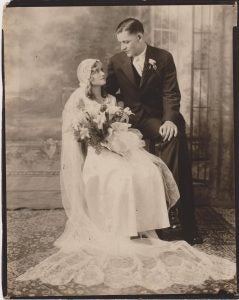Continuing with the theme of gender inequality in wedding traditions, this post will focus on how gender is communicated through professional wedding photography.
Lewis (1997) uses a case study, including participant observation, interviews, and document analysis, to show how wedding photography provides important information in understanding how visual communication affects how people create meaning in their lives.
Lewis situates his research within the framework of cultural hegemony. Hegemony’s greatest power lies in the fact that it “gives” at the same time that it “takes.” A bride is beautiful at the same time she is being objectified. One series of wedding photographs may not cause women to be submissive, but the danger occurs when similar images feed into a larger system in which stereotyped views of submissive women are common, when real life poses are pulled out of context and repeated in contrived photographs.
The hegemonic process works because the wedding industry and professional photography have become accepted – the ideologies present in the wedding ritual and its photographic artifacts are not questioned. So, although the wedding may be enjoyable and incorporate some individuality, it is still bound by cultural ideals that promote certain ways of seeing the world and contributes to social realities such as class dominance and gender inequality.
Posing in wedding photographs often highlights gender displays that depict unbalanced power relations between men and women; men are depicted in power poses and women are portrayed as submissive or less empowered than men. For example, photographers routinely pose women in the “S Curve” where the woman’s head is tilted toward her shoulder and her chin is up, exposing her neck – the exposed neck indicates vulnerability. In contrast, men are routinely posed in the “C Curve,” where the chin is down and the head is tilted toward one slightly dropped shoulder so that the angle between the shoulder and head is about 90 degrees, suggesting something solid and sturdy – there is no exposed neck and thus no vulnerability. Although women are sometimes posed in C Curves, men are never posed in S Curves.
Lewis (1997) references several other categories of gender stereotyping in photographs as identified by the sociologist Erving Goffman. Men are often shown embracing women which can be interpreted as a power relationship where he is in control. Social weight is displayed through physical size, where a man’s height over a woman is emphasized – men even stand on boxes to appear taller if they are not. Sometimes the woman is shown sitting and/or gazing up at the man while he is standing over her. In hand holding poses, the back of the male hand usually faces the viewer, indicating protective power. What a theorist like Goffman would see as a submissive pose, brides apparently just see a well-constructed romantic photograph.
Reference: Lewis, Charles. 1997. “Hegemony in the Ideal: Wedding Photography, Consumerism, and Patriarchy.” Womens Studies in Communication 20(2):167–88.
